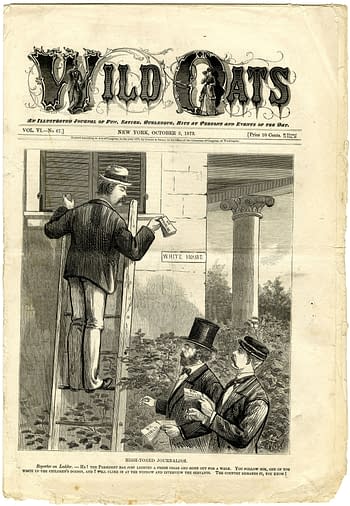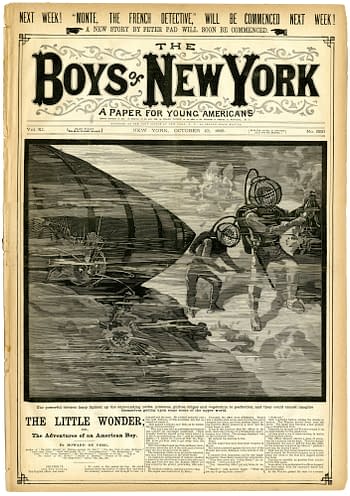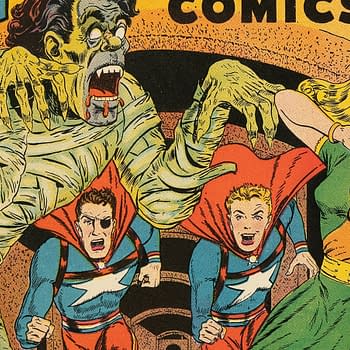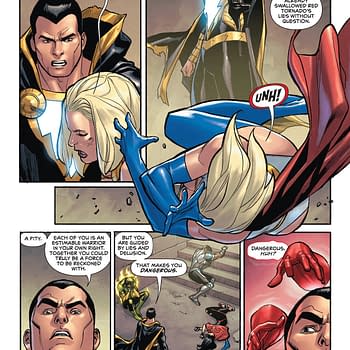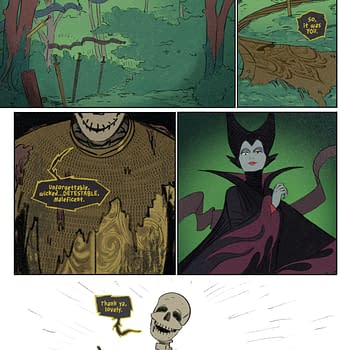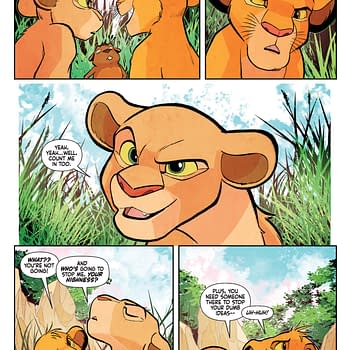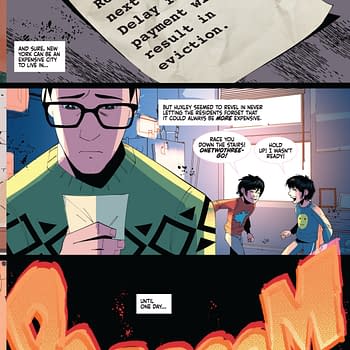Posted in: Comics, Vintage Paper | Tagged: boys of new york, frank tousey, george g. small, norman munro
When Comic & Dime Novel Pubs. Lost 5th Ave. Real Estate in a Pool Game
It seems that one evening around the first week of March 1876, dime novel publishers Norman Munro and Frank Tousey and comic paper publisher and editors George G. Small and John A. Harrington were enjoying a game of pool at Tim Flynn's Billiard Room, when the stakes got rather heated. The three publishers mentioned were among the most important newsstand publishers of their era. In particular, Frank Tousey had a seismic influence on the direction of adventure and science fiction periodicals in America, while George G. Small was one of the most noteworthy early comic paper editors in American history.

The timing of the match itself is interesting in the context of the publishing history of the era. Judging by the issue of Illustrated Sporting New Yorker in which this blurb appeared, the game took place around the first week of March. That's just a month after Tousey and Munro's building on Beekman Street burned down. The duo didn't skip a beat and were able to maintain operations while setting up in a new location.
It was also just a few days after Tousey and Munro published Boys of New York #28, the debut of the Frank Reade franchise, which would help change the course of science fiction in America.
The four men engaged in the first match described here would have multiple associations over the years. Tousey and Munro were partners at the time, while Harrington was Small's editor on Wild Oats, an influential comic paper which featured many if not most of the best cartoonist of the day during its historic 12-year run 1870-1881. Small and much of the Wild Oats staff would help Tousey launch Judge in 1881. The magazine of comic art, political commentary, satire, and news would last until 1947 and become influential over the rising tide of Golden Age comic book artists as they came of age.
The anecdote about this game comes from Illustrated Sporting New Yorker, which Tousey and Munro would sell to Small and his partner John Collins the June after this game of billiards took place. Tousey and Munro would dissolve their partnership the next year, and then Tousey and Small would briefly become business partners. The new publishing enterprise would eventually acquire Boys of New York from Munro, turning it into one of the most important titles in American newsstand history. Boys of New York is 1000 issues even of science fiction, horror, adventure, weird tales, and even proto-superhero shock and awe. Some of their titles also contained comics. Small would later drop out of the business partnership but continued working for Tousey. Small suffered from tuberculosis, and apparently self-medicated with alcohol. He had a reputation as a genius but a drunkard.
Tim Flynn's Billiard Room was in the basement of the New York Times building on Park Row. This area was the epicenter of the publishing universe, and all the participants here had offices nearby. There's a glimpse of its basement entrance visible in the attached 1873 photo, I think — at the corner of the building which is foreground right in this photo, there's a man standing next to a basement entrance which appears to have a sign that appears to say "Billiards" on it.
The original owner of the 5th Ave. plot put up for wager is not clarified in the story, but one suspects it would be Norman Munro. Munro was well known for rolling his publishing wealth into greater real estate riches in later years. In 1889, Munro held a national fan convention in a building he owned in New Jersey which also contained a skating rink. The convention was for members of his Golden Hours Club, a fan organization for his weekly story paper of the same name. After his death, Munro's primary estate was purchased by a member of the Guggenheim family. It is now part of the campus of Monmouth University in New Jersey.
I was unable to identify the pool hustling French artist Swazie (perhaps a misspelling of Swayze?) here, but he was likely a comic artist or illustrator for one or more of the publishers in the area.
The original article follows below.
- Wild Oats, October 3, 1873.
- Boys of New York #530, October 10, 1885.
AN AMATEUR BILLIARD MATCH.
It came off at Tim Flynn's a day or two ago. The contestants were Messrs. Munro and Tousey against Messrs. Small and Harrington. The match was for curry and Chablis, four ball, 100 points up, best three in five, to harness.
Munro led off with a startling masse shot which caused Small to exclaim: " That's a bloody scratch!" Tim Flynn, who was referee, decided that it was au fait, but said it was the biggest thing he ever saw at billiards; and Munro went on as though nothing had happened, and sent the cue ball on an exploring expedition around the room. Small got in and missed—Tousey had soaped his one point. The latter then braced himself for a sublime effort, and by a masterly double stroke, made a brilliant run of one, and slipped up on a shot that Sexton could have made easily. Harrington then got in and scored a fine miss, which he claimed was a "foul," but not allowed by referee. Munro then chalked his cue carefully, and looked capable of achieving any number of billiards, just as he struck his ball which perverse sphere, however, after striking the object ball, went in a contrary direction from that intended by the striker, and bounced off the table.
Small then came to the front and rolled up two for his side, when Tousey got in, and by a transverse, centrifugal masse shot, which astonished the referee, added one to the score of his side, and followed this up with some hot shots, such as Tim Flynn says he never saw before. This play seemed to open things as it were, some fearful and wonderful playing by all hands taking place. At the end of an hour and thirty-five minutes, the score stood: Small and pard, 11; Munro and pard, 9; and the referee asleep. In two hours and forty minutes from the start, the first game was achieved, both sides having one hundred points up, and both claiming the game. To settle the dispute, the referee refusing to be roused up to the importance of the occasion, a French gentleman, Mons. Swazie, artist, who had enjoyed the remarkable playing, agreed to play against the four, for a lot on Fifth avenue, he to have the opening of the game. His offer was accepted on the spot, and he went to work, while the others winked at one another (they had a soft thing, you know), and chalked and sand-papered their cues in the most thorough manner.
Munro was to get in after the French gentleman, and he kept sand paper and chalk in constant use, the others keeping the articles busy as well. In fifteen minutes the French gentleman laid down his cue, the winner of the lot on Fifth avenue, having run 100 points, the referee, strange to say, having waked up and seen the play of the French gentleman, whom he want-ed to tackle at pin-pool, Tim's strong hold. The party concluded not to play any more, Tim advising them to tackle fish-balls rather than billiard balls. They followed his advice, and adjourned to the Dime Restaurant, where they rastled with fish-balls and things, without Chablis. Tim says he never saw such playing before; and if everybody played so, he would have to close his room.


